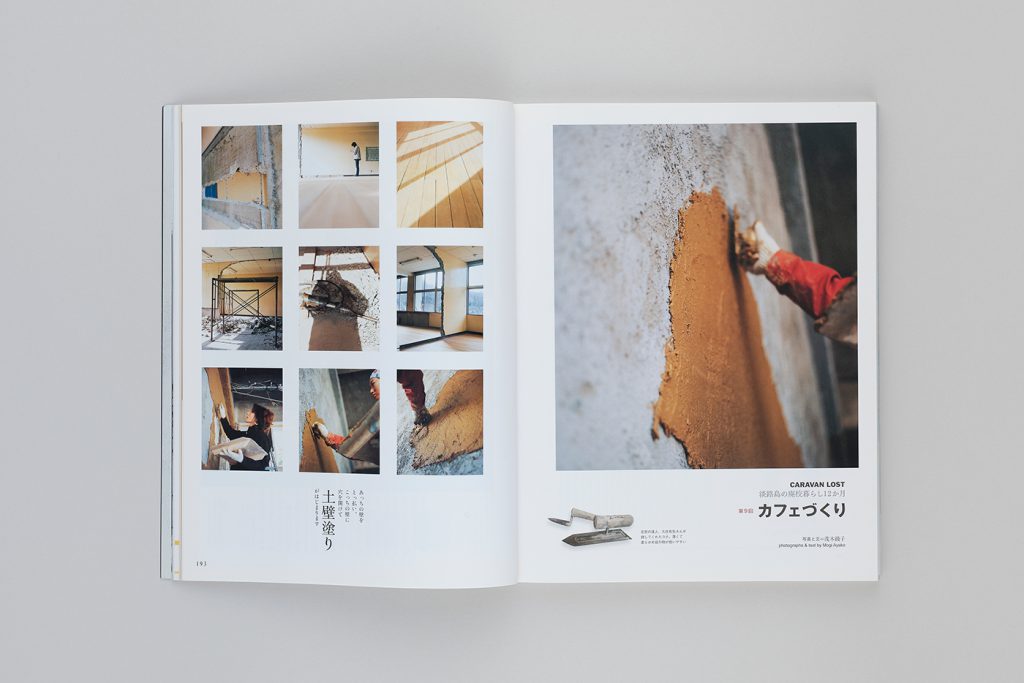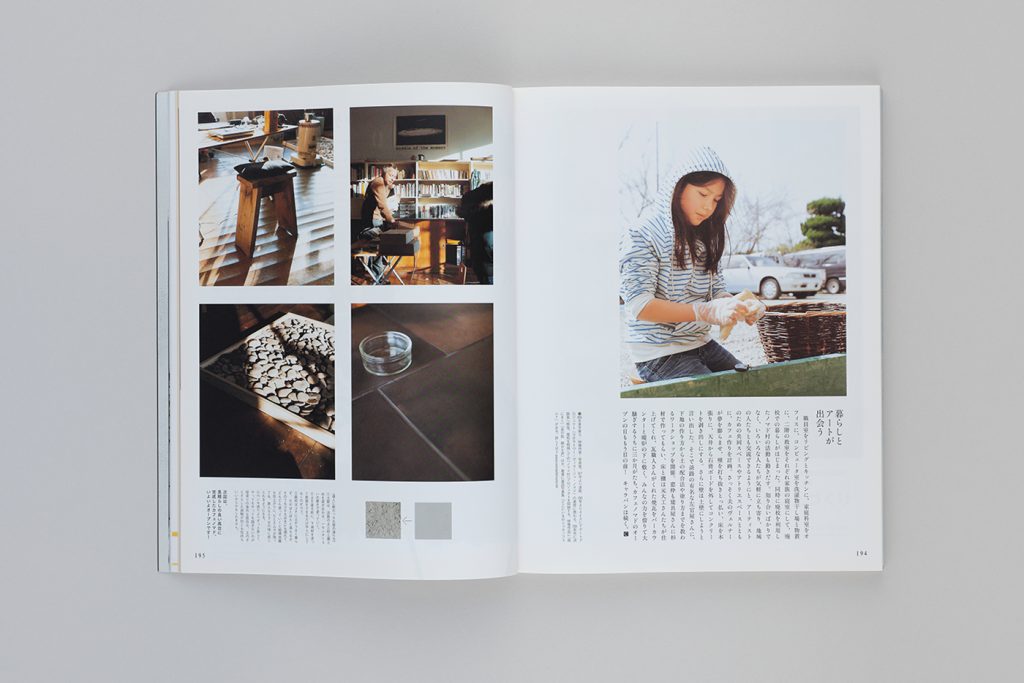

写真と文=茂木綾子
職員室をリビングとキッチンに、家庭科室をオフィスに、コンピュータ室を洗濯物干し場と物置に、2階の教室をそれぞれ家族の寝室にして、廃校での暮らしがはじまった。同時に廃校を利用したノマド村の活動も動きだす。知り合いばかりでなく、いろいろな人たちが気軽に立ち寄り、地域の人たちとも交流できるようにと、アーティストのための共同スペースやアトリエスペースとともに、カフェづくりを計画。さっそく夫のヴェルナーが夢を膨らませ、壁を打ち抜きとっ払い、床を木張りに、天井から石膏ボードを外してコンクリートを剥き出しにする。さらに壁を土壁にしようと言い出した。そこで淡路の有名な左官屋さんに、下地のつくり方から土の配合法や塗り方までを教わるワークショップを開催。窓枠も建具屋さんに杉材でつくってもらい、床と棚は元大工さんたちが仕上げてくれ、瓦職人さんがくれた焼瓦をバーカウンターと暖炉の下に敷く。みんなの力を借りて大騒ぎするうちに3か月がたち、カフェノマドのオープンの日ももう目の前! キャラバンは続く。
● 達人に教わった土壁の塗り方
❶ 土壁は、淡路の土と砂と藁と水を混ぜ合わせ、1センチくらいの暑さで塗っていく。
❷ 土を塗る前に、下地材を塗って表面をできるだけ平らにしておくのがコツ。❸ 最初はコテに土がうまく乗らず、土がぽたぽたと落ちるが、そのうちコテさばきにも慣れて、どんどん塗っていくとけっこう綺麗な仕上がりに。たとえムラが残っても、素人ならではの味に感じられるようになる。❹ ペンキ塗りよりずっと楽しく、やってもやっても飽きないのが壁塗りの意外な面白み。土のざらざらした感触が何とも気持ちいいからかもしれません。
—
職員室をリビングとキッチンに、家庭科室をオフィスに、コンピュータ室を洗濯物干し場と物置に、2階の教室をそれぞれ家族の寝室にして、廃校での暮らしがはじまった。同時に廃校を利用したノマド村の活動も動きだす。知り合いばかりでなく、いろいろな人たちが気軽に立ち寄り、地域の人たちとも交流できるようにと、アーティストのための共同スペースやアトリエスペースとともに、カフェづくりを計画。さっそく夫のヴェルナーが夢を膨らませ、壁を打ち抜きとっ払い、床を木張りに、天井から石膏ボードを外してコンクリートを剥き出しにする。さらに壁を土壁にしようと言い出した。そこで淡路の有名な左官屋さんに、下地のつくり方から土の配合法や塗り方までを教わるワークショップを開催。窓枠も建具屋さんに杉材でつくってもらい、床と棚は元大工さんたちが仕上げてくれ、瓦職人さんがくれた焼瓦をバーカウンターと暖炉の下に敷く。みんなの力を借りて大騒ぎするうちに3か月がたち、カフェノマドのオープンの日ももう目の前! キャラバンは続く。
● 達人に教わった土壁の塗り方
❶ 土壁は、淡路の土と砂と藁と水を混ぜ合わせ、1センチくらいの暑さで塗っていく。
❷ 土を塗る前に、下地材を塗って表面をできるだけ平らにしておくのがコツ。❸ 最初はコテに土がうまく乗らず、土がぽたぽたと落ちるが、そのうちコテさばきにも慣れて、どんどん塗っていくとけっこう綺麗な仕上がりに。たとえムラが残っても、素人ならではの味に感じられるようになる。❹ ペンキ塗りよりずっと楽しく、やってもやっても飽きないのが壁塗りの意外な面白み。土のざらざらした感触が何とも気持ちいいからかもしれません。
—
photographs & text by Ayako Mogi
The staff room was turned into a living room and kitchen, the home economics room into an office, the computer room into a laundry drying area and storage room, and the classrooms on the second floor into bedrooms for the family. At the same time, the activities of Nomad Village using the closed school started. She planned to create a café as well as a communal space for artists and a studio space so that not only acquaintances but also people from all walks of life could drop by and interact with the local people. Her husband, Werner, immediately started dreaming of a new space, where the walls would be punched out and removed, the floor would be covered with wood, and the plasterboard would be removed from the ceiling to expose the concrete. He also wanted to make the walls mud walls. So we held a workshop with a famous plasterer in Awaji to learn how to make the base, mix the clay, and paint it. The window frames were made of cedar wood by a joiner, the floor and shelves were finished by former carpenters, and burnt tiles from a tile maker were placed under the bar counter and fireplace. With everyone’s help, three months passed, and the opening day of Cafe Nomade was just around the corner! The caravan continues.
● How to paint an earthen wall taught by a master
❶ To make a mud wall, mix Awaji soil, sand, straw, and water, and apply the mixture at a thickness of about one centimeter.
❷ Before applying the soil, the trick is to apply a base material to make the surface as flat as possible.
❸ At first, the soil doesn’t sit well on the trowel, and it drips down, but eventually you will get used to using the trowel, and as you apply more and more, you will get a beautiful finish. Even if some unevenness remains, you can feel it as an amateur’s unique taste.
❹ Painting walls is much more fun than painting, and the unexpected fun of painting walls is that you never get tired of doing it. Maybe it’s because the rough texture of the soil feels so good.
The staff room was turned into a living room and kitchen, the home economics room into an office, the computer room into a laundry drying area and storage room, and the classrooms on the second floor into bedrooms for the family. At the same time, the activities of Nomad Village using the closed school started. She planned to create a café as well as a communal space for artists and a studio space so that not only acquaintances but also people from all walks of life could drop by and interact with the local people. Her husband, Werner, immediately started dreaming of a new space, where the walls would be punched out and removed, the floor would be covered with wood, and the plasterboard would be removed from the ceiling to expose the concrete. He also wanted to make the walls mud walls. So we held a workshop with a famous plasterer in Awaji to learn how to make the base, mix the clay, and paint it. The window frames were made of cedar wood by a joiner, the floor and shelves were finished by former carpenters, and burnt tiles from a tile maker were placed under the bar counter and fireplace. With everyone’s help, three months passed, and the opening day of Cafe Nomade was just around the corner! The caravan continues.
● How to paint an earthen wall taught by a master
❶ To make a mud wall, mix Awaji soil, sand, straw, and water, and apply the mixture at a thickness of about one centimeter.
❷ Before applying the soil, the trick is to apply a base material to make the surface as flat as possible.
❸ At first, the soil doesn’t sit well on the trowel, and it drips down, but eventually you will get used to using the trowel, and as you apply more and more, you will get a beautiful finish. Even if some unevenness remains, you can feel it as an amateur’s unique taste.
❹ Painting walls is much more fun than painting, and the unexpected fun of painting walls is that you never get tired of doing it. Maybe it’s because the rough texture of the soil feels so good.